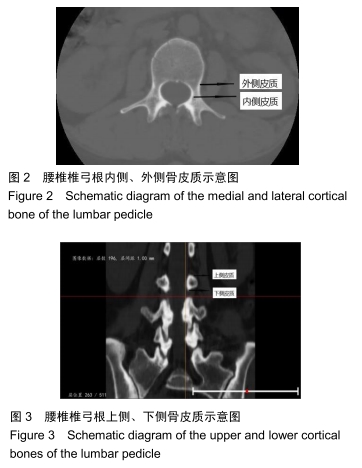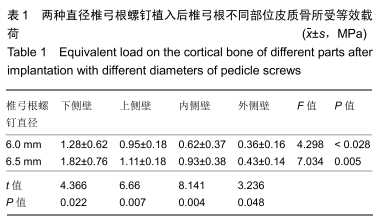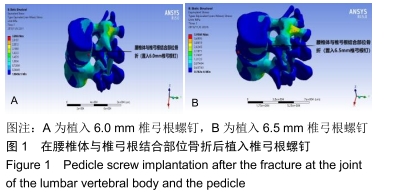中国组织工程研究 ›› 2020, Vol. 24 ›› Issue (18): 2794-2798.doi: 10.3969/j.issn.2095-4344.2656
• 骨与关节生物力学 bone and joint biomechanics • 上一篇 下一篇
植入不同直径椎弓根螺钉后腰椎体与椎弓根结合部位骨折力学的稳定性
宗治国1,刘 肃1,马朋朋1,张 鑫1,李 伟1,苏 峰1,张春林1,郭建文2,文 毅3
- 1河北北方学院附属第一医院脊柱外科,河北省张家口市 075000;2张家口市宣化区人民医院骨外科,河北省张家口市 075000;3湖州市南浔区人民医院,浙江省湖州市 313000
Mechanical stability of the fracture at the junction of lumbar vertebral body and pedicle after implantation with different diameters of pedicle screws
Zong Zhiguo1, Liu Su1, Ma Pengpeng1, Zhang Xin1, Li Wei1, Su Feng1, Zhang Chunlin1, Guo Jianwen2, Wen Yi3
- 1Department of Spinal Surgery, the First Affiliated Hospital of Hebei North University, Zhangjiakou 075000, Hebei Province, China; 2Department of Orthopedics, Xuanhua People’s Hospital of Zhangjiakou, Zhangjiakou 075000, Hebei Province, China; 3Nanxun People’s Hospital of Huzhou, Huzhou 313000, Zhejiang Province, China
摘要:

文题释义:
腰椎体与椎弓根结合部位骨折:此为腰椎弓根骨折中的一种类型,腰椎弓根骨折还包括椎弓根体部骨折、椎弓根与椎板结合部位骨折,而腰椎体与椎弓根结合部位骨折较椎弓根体部骨折更为稳定,多数学者主张此型骨折可以经伤侧椎弓根植入椎弓根螺钉。
三维有限元:该方法是目前力学仿真的主要方法之一,通过获取人体的CT或MRI数据,建立逼真的三维模型,再通过将模型网格化,赋予网格相应的材料属性,然后再进行力学分析。因为该方法是获取人体数据后建模,较动物实验更能有效模拟人体结构发生变化时的力学变化。
背景:多数学者认为腰椎与椎弓根结合部位骨折较为稳定,可经由伤侧椎弓根植入椎弓根螺钉来提高骨折断端的稳定性,但经伤侧椎弓根植入的椎弓根螺钉直径大小与椎弓根、椎体所获得的力学稳定性、安全性目前尚有争议。
目的:利用三维有限元法分析不同直径椎弓根螺钉植入椎弓根内与椎弓根皮质关系对骨折腰椎与椎弓根力学稳定性的影响。
方法:基于正常成人L2-L3 CT DICOM数据,通过mimics软件建立L2椎体一侧腰椎体与椎弓根结合部位骨折模型,同时建立L3椎体三维模型。将制作好的L2-L3模型以stl格式导入3-matic中,建立经L2椎体与椎弓根结合部位骨折处植入不同直径椎弓根螺钉(椎弓根螺钉直径分别为6.5,6.0 mm,长度均为45 mm)的模型,将上述模型在mimics软件中赋予材料属性后导入ansys中,在L2椎体上表面施加500 N的垂直载荷,模拟标准体质量成人经伤椎植入不同直径螺钉后直立情况下的生物力学表现。
结果与结论:①植入6.0 mm螺钉后,腰椎体与椎弓根结合部位椎弓根下壁、上壁、内壁、外壁所承受的等效载荷分别为(1.28±0.62),(0.95±0.18),(0.62±0.37),(0.36±0.16)MPa,4组间比较差异有显著性意义(F=4.298,P < 0.05);②植入6.5 mm螺钉后,腰椎体与椎弓根结合部位椎弓根下壁、上壁、内壁、外壁所承受的等效载荷分别为(1.82±0.76),(1.11±0.18),(0.93±0.38),(0.43±0.14)MPa,4组间比较差异有显著性意义(F=7.034,P < 0.05);③植入6.5 mm椎弓根螺钉模型椎弓根下壁、上壁、内壁、外壁所承受的等效载荷均大于植入6.0 mm椎弓根螺钉模型对应处(P < 0.05);④结果表明,椎弓根螺钉越大对腰椎体与椎弓根结合部位皮质骨的压力载荷越大,把持力越强;椎弓根上壁、下壁、内壁、外壁所承受的载荷与其皮质厚度呈正相关,下壁皮质骨最厚,其承受的等效载荷最大,外侧壁皮质骨最薄,其承受的等效载荷最小;椎弓根螺钉在椎弓根内越靠近下内侧壁,其把持力越强、稳定性越好,越靠近上外侧壁其把持力越小、稳定性越差,但上外侧壁较下内侧壁置钉更为安全,置钉时仍需依据手术医师的经验权衡利弊进行。
ORCID: 0000-0003-0823-4728(宗治国)
中国组织工程研究杂志出版内容重点:人工关节;骨植入物;脊柱;骨折;内固定;数字化骨科;组织工程
中图分类号:


